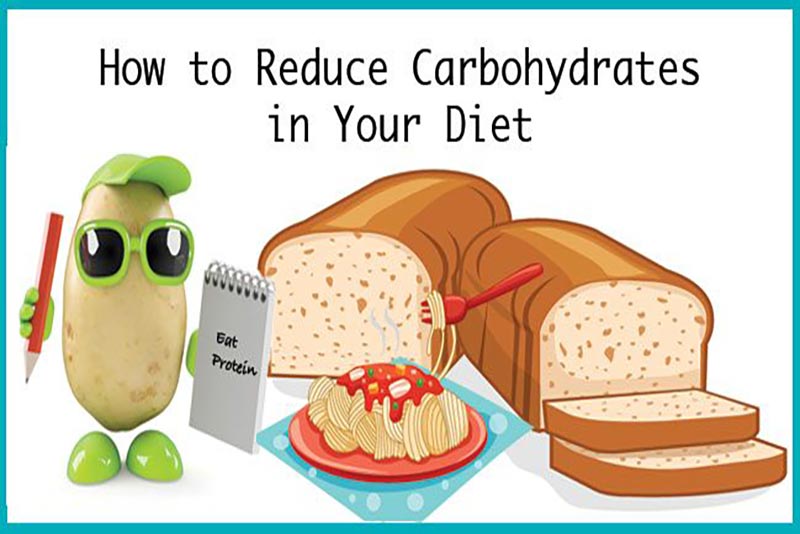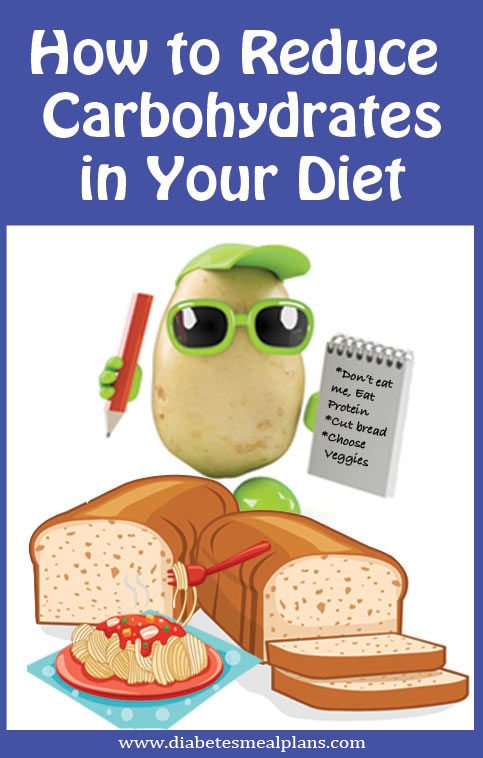Reducing carbohydrates helps improve anyones health, and for a type 2 diabetic it is one of the single best things you can do to lower glucose levels, improve a1c, and lose weight too.
So we thought it might be a good idea to chat about how to reduce carbohydrates in your diet, and we’ve got 4 steps with some ideas and alternatives to help get you started.

1. Do It One Step At A Time
Okay, some people can go cold turkey and cut out all forms of carbs but most people find it fairly restrictive to just go cold turkey. So the other option is to do it one step at a time to avoid the major withdrawals and perhaps the binge eating that follows.
Have you ever cut out the sugar?
Or maybe cut out coffee?
Well, cutting down the carbohydrates can be much the same. You WILL have some kind of withdrawal if you just make the cut.
So it’s better to do it one step at a time and reduce your intake slowly. That way you can find some great alternatives and get into a better eating pattern and routine that you can stick to and enjoy. We’ll be talking about alternatives down the page and finding alternatives is the key to carb reduction.
2. Avoid Beverages High In Sugar
Beverages (aka drinks) are the easiest way to over consume carbohydrates in your diet.
So as a rule: DON’T drink your sugar!
Drinks high in sugar include soft drinks, cordials, sports drinks, flavored mineral waters, and fruit juice. Yes fruit juice is natural but it is still sugar/carbs and A LOT of them at one sitting!
Also, be careful you don’t want to swap these out for diet sodas because they are just as bad.
So here are a few alternatives:
- Water = your absolute best friend – remember your blood sugar is measured per liter and when we drink water this helps dilute the blood stream and bring down blood sugar levels.
- Try fizzy soda water with lime and mint leaves, or you could use lemon as well.
- Make herbal fruit teas like blackcurrant or raspberry tea, allow them to cool, put them in the fridge and drink them on ice.
- Make a fizzy herbal tea drink – follow the method above and then add some soda water to the mix.
3. Eat Protein Rich Snacks
Although we often crave carbs, have you noticed that they don’t keep you full for very long?
And have you noticed that when you eat more chocolate or carbs you often crave more of those foods?
Protein doesn’t cause this response and it is naturally more satiating, meaning it fills you up more and keeps you fuller longer!
The key here is organization, by prepared and then you can’t go wrong.
Here are 5 ideas for protein rich snacks.
- 1/4 cup cottage cheese topped with some blueberries
- Hard boiled eggs
- A handful of nuts or seeds
- Eat a leftover meat patty or sliced chicken breast slices
- A tablespoon of nut butter like almond butter or peanut butter
Of course there are plenty more protein filled snacks but this gives you a good place to start.

4. Keep a list of carbohydrate replacements handy
Here are 10 great ideas to help get you started:
- Replace rice with cauliflower rice
- Replace mashed potato with mashed cauliflower
- Replace pasta with konjac noodles
- Replace bread with lettuce leaves and make a breadless burger (we’ve got loads of bread recipes in our members site)
- Triple your veggie intake, the fiber is awesome, has loads of benefits and fills you up
- Replace crackers with veggie sticks or try having your boiled eggs on top of slices of cucumber with cheese…delicious!
- Make a sandwich wrap with lettuce instead of bread
- Don’t include pasta, just make a tuna cheesy bake without it, load it with veggies
- Skip the toast and cereals for breakfast and try eating eggs and veggies at breakfast
- Replace crisps with a handful of nuts – all kinds are super healthy!
The key is to drastically cut down or cut out bread, potatoes, cereals, rice, wheat products, flour, most fruits (apart from berries and a few others), and keep beans and legumes limited.
Get your carbohydrates from VEGETABLES!
Eat lots of fresh salads and eat loads of vegetables – especially ones that grow above the ground.
That should give you some ideas on how to reduce carbohydrates in your diet!
But hey…it’s no good just thinking about it, if you really want to reduce carbohydrates in your diet, you actually have to be prepared to DO IT.
It’s actually not as hard as you think.
Here’s a note from our Founder:
“I remember the first time I served cauliflower rice to my partner and he was pleasantly surprised that it tasted almost exactly like rice. He also never used to like vegetables for breakfast. Now he eats my vegetables filled omelet’s without a sound and loves them too.”
Dietary adjustments are not the end of the world. In fact, most of the time they are the best thing we can do for ourselves.
So just start with one thing and keep making those swaps and alternatives.
Wishing you the best in health.
P.S. Have you got anymore cool ideas or things that have worked for you? Leave your comments below and share them with others.

Mish
Just wondering. What is the difference between the south beach diet and this low carb diabetes meal plan? Thanks for the great tips. Always helpful reminders.
Jedha: Nutritionist (MNutr)
We haven’t really studied the South Beach Diet in detail but it does have similarities in terms of reducing carbohydrates in the diet and focusing on whole foods. The service we provide here focuses only on type 2 diabetes and prediabetes, so that is certainly a major difference we know of.
laurie
excellent info thanks
Alex
How do I join the website
Jedha: Nutritionist (MNutr)
Hi Alex, if you wish to join as a member, you can find the details here.
Terrell
This is such a great article! My eating habits have been the hardest thing to change. I make plans and even buy the food but fail to follow through, meaning the food goes to waste cause I don’t cook it! But here I am, once again, making a commitment to do this and develop the habit and become disciplined. I had my blood work done today and it’s high, 7.1. I am on a low dosage of Metformin and I work out 4 days a week. This proves that it’s my eating habits. Sorry for the long post but it’s something about typing this publicly, it makes it real for me. The Diabetes Association should really start to preach what you teach. Thank you!
Emily - Dietitian (MS, RD)
Terrell, I encourage you to join more of our discussions. For many, this online community can help them stay focused and commit to doing the things they know they should be doing. You may even consider joining us as a member for even more recipes to help keep you on the right track.
Let us know if there is any other way we can help! Keep us updated on your progress!
Jay
Hello I have a question. Do you suggest one who is pre or T2 Diabetic to go on the Atkins diet? To reverse or intake low carbs?
Jedha
Hi Jay, we encourage a low carb diet here because research shows it works, so yes lowering your intake of carbs is a good strategy. However, Atkins is a ‘very’ low carb diet 20 g max per day. Some studies have shown a very low carb diet is beneficial and some people find eating 20-30 g a day is how low they need to go to manage their diabetes.
BUT it is more difficult to sustain a very low carb diet and you cut out lots of plant foods that have loads of nutritional benefits.
For example, carrots and beets are not in the Atkins diet because they are root vegetables, but although they do contain slightly more carbs, they also contain loads of fiber, vitamin, minerals, and flavonoids.
If you’re taking meds, particularly insulin, it’s also important to get help from a doctor or dietitian because the lowered carb intake requires adjustment of meds. Hope that helps :)